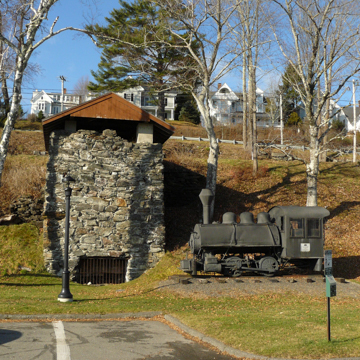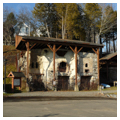Located on a waterfront site in Rockport Harbor in West Penobscot Bay, just below Camden, Rockport’s five surviving limekilns are the last vestige of a once-thriving Maine industry that provided essential building materials to major cities on the east coast. The remaining kilns were active for a significant part of the nineteenth century, although their exact age has not yet been determined. Made of granite fieldstone and lined with brick, the kilns were top loaded with chunks of limestone and fired with “kiln wood,” that is, wood dried in a kiln.
The presence of limestone deposits, and the proximity of Maine’s rich spruce forests for fuel, made Rockport a site for the lime-burning industry as early as 1733. The first kiln was located on land owned by Major-General Henry Knox, a member of George Washington’s cabinet. Almost all of Maine’s limestone came from Knox County towns (Thomaston, Rockland, Rockport, and Camden), which all had large limestone deposits. Waterfront towns like Rockport were considered ideal for industrial processing since cordwood from Canada and further down the east coast was easily delivered by schooners, though after the Civil War, railroads brought the limestone to the kilns over trestles. The processing of limestone began when head-size chunks were top-loaded into the kilns; after burning, the powdered lime produced by the fire was shoveled into barrels for shipment. Limestone was dangerously combustible when it came in contact with moisture, yet from Knox County ports schooners carried the hazardous lime to places like Boston, Philadelphia, and New York. In 1817 limestone for plaster was shipped to Washington, D.C. for building projects throughout the nation’s capital.
Between 1870 and 1900 the industry flourished in Maine. An 1875 map shows eight lime kilns on the Rockport Harbor site. In the 1890s Maine produced three-quarters of all the lime sold in New York; it was used as mortar for brick binding, fertilizer for farms, and finishing plaster for residences and commercial buildings. In 1899 fourteen kilns operated in Rockport, five owned by the Carleton, Norwood and Company, three by S.E. and H.L. Shepherd. A kiln owned by Jotham Shepherd sat very near the site of the surviving kilns. After 1900 coal increasingly replaced cordwood. An especially severe fire in 1907, caused by lime’s inherent volatility, lessened the importance of these waterfront kilns and ultimately sealed the fate of Rockport’s limestone industry.
The Friends of Rockport Harbor Trust purchased the site in 1970. When they began to study the kilns, they discovered that only five were in good enough condition to be restored. Materials from the additional two were used to complete the restoration. Now situated in a Rockport Marine Park, the site has useful interpretative signage. One of the trestles used to deliver fuel to the furnaces is also extant.
References
Briggs, John W., “Rockport Historic Kiln Area,” Knox County, Maine. National Register of Historic Places Inventory-Nomination Form, 1969. National Park Service, U.S. Department of Interior, Washington, D.C.
Judd, Richard W., Edward A. Churchill, and Joel A. Eastman, ed. Maine: The Pine Tree State from Prehistory to the Present.Orono: University of Maine Press, 1995.
MacLachlan, Courtney C., David R. Hoch, and Paul G. Merriam. Images of America: Rockland Area Lime Industries.Chicago: Arcadian Publishing, 2006.



















